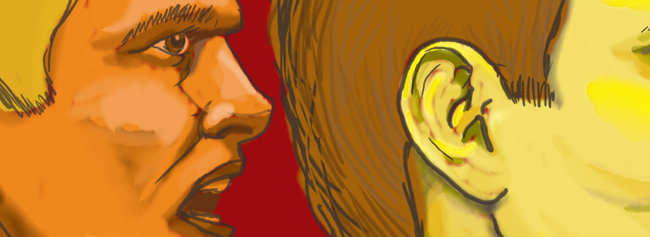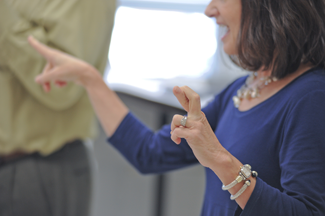Feature Story
Deaf Education Program Empowers Future Teachers and Students

When Virginia seeks help to meet a critical shortage of teachers for the deaf and hard of hearing, RU steps up.

Ellen Austin at work
For Ellen Austin, it all started at a department store jewelry counter when she was in high school. As Austin waited her turn to purchase a pair of earrings, she observed two women trying to communicate with the salesperson behind the counter. There was a problem: The two women spoke through sign language, and the salesperson did not.
“I thought to myself, ‘If only I knew how to sign, I could help this situation,’” said Austin.
That exchange led Austin to dedicate her life to deaf education and eventually to Radford University, where she helped to spearhead the only deaf education preparation program for the Commonwealth of Virginia.
The program was born from a critical shortage of teachers for deaf and hard-of-hearing students, said Lissa Power-deFur, professor and graduate program director for communication sciences and disorders at Longwood University. In 2001, Power-deFur was responsible for speech and language programs at the Virginia Department of Education. “It was obvious that, if we were going to make improvements in the services we were able to offer our K-12 students, we needed a program to train teachers in deaf education.”
“Other universities, including the University of Virginia and Longwood, had tried in the past to offer deaf education degree programs, but budgetary and staffing constraints had proved problematic,” said Power-deFur. Knowing that any future program would need financial support from the state for success, she worked within budgets at the Virginia Department of Education to find funding. The next step: finding the right university to house the program.
Power-deFur had previously worked at RU and knew the expertise the university could bring to the table. She made the trip to Radford to meet with her former colleagues to discuss the possibilities with them.
“Everyone was really open to the idea, despite the challenges that existed. They were willing to take a risk, and it paid off.”
It was also Power-deFur who brought Austin’s name forward as a person who would have not only the experience but also the enthusiasm to lead the program. Austin had taught children with hearing loss in public schools for 22 years, including 15 years as coordinator for the Roanoke Valley Regional Program for the Deaf and Hard of Hearing.
While Austin had originally planned to focus on continuing her education in the field as opposed to a new career move, she agreed to try her hand in a different type of classroom.
“It was absolutely Ellen’s passion that led to the successful creation of this program,” said Pat
Shoemaker, dean of RU’s College of Education and Human Development.

Students in the summer deaf education workshop
And the rest, as they say, is history.
For the past 11 years, Austin has developed a program that is challenging and rewarding to its students and provides the highest-quality teachers for the Commonwealth.
The program, a collaboration between the School of Teacher Education and Leadership and the Department of Communication Sciences and Disorders, is offered at both the bachelor's and master's levels. A licensure option is also available for unendorsed educators currently serving as teachers of students who are deaf and hard-of-hearing or for other professionals who want to add
an endorsement in hearing impairment.
Students participate in standard course work in education, student learning and development, and they also take classes in American Sign Language (ASL), language development and audiologic
rehabilitation.
"Our program is similar to pursuing two majors," said Austin. "Not only must they complete the teacher education training, they must also become fluent in ASL. It's a language that carries its own syntax and semantics; it would be like learning Spanish or French for other students. I say it all the time, but I really do have the best students on campus. Their dedication to their studies and their future profession is incredible."
Her students, it seems, feel the same way about her.
"Ellen Austin leads by example and expects her students to behave in ways that reflect positively on the program and the university," said graduate student Kayla Whedbee. "She is energetic and brings a lot of enthusiasm and passion into the classroom. She is motivated to provide us with the pertinent information so we can become the best teachers we can be."
Austin said this is because her students will one day teach children whose needs run the gamut in deaf education. "The population these future teachers will serve is vast. Therefore, the education we provide our students must also be vast so they can meet the needs of their students."
To ensure that graduates of the program can match the learning styles, skill levels and auditory abilities of their students, they learn about a variety of communication and instructional methods, including oral-aural, cued speech, auditory-verbal, total communication and bilingual-bicultural methods.
Austin also stresses the importance of hands-on learning. Beginning in an undergraduate's junior year, he or she is in an actual classroom, learning from observing and from doing.
The students begin by shadowing itinerant deaf education teachers who are working in oral, resource and self-contained classrooms. Each student is then required to tutor a child for six to eight sessions, adapting his or her skills to meet the child's learning style and needs.
This is typically done in hearing classrooms that include children who are deaf or hard of hearing, in resource rooms, and/or in self-contained classrooms for students who are deaf. Their student teaching is done in a residential setting at the Virginia School for the Deaf and the Blind in Staunton. This experience provides total immersion for the students, said senior Amanda Hale, who is looking forward to her time there this year.
"We live in dorms during our time student teaching," said Hale. "This is really great. We are able to be working and communicating with the deaf every day."
The experience also gives the students a unique look at the potential impact of their future careers, said Nancy Armstrong, superintendent of the Virginia School for the Deaf and the Blind.
"Being around these students, future teachers see what students can become. Students who have visual and hearing problems, although they are labeled as disabled, don't feel that way here. Everyone signs. There is potential for any deaf child to excel, and that's good to see for those studying in the field. The sky is the limit."
To reach this potential, the children need the educators Radford University is producing.
The area of special education is No. 1 in teacher shortages across the state, and there is no indication that will change in the near future, said Deborah Pfeiffer, a specialist with the Virginia Department of Education.
"Many of the special education teachers in the Commonwealth currently are reaching or exceeding retirement age, so having Radford University's program has been really important," said Pfeiffer. "No Deaf Ed program produces large numbers of teachers, but hopefully, those who do graduate from RU are more likely to stay in Virginia. We have confidence that Radford is producing skilled, knowledgable teachers."
This is Ellen Austin's goal every day: to produce educated, well-rounded teachers who are excited about their field.
If senior Kayla Price is any indication, Austin is succeeding.
"The way I look at it, Ellen wants all of us to be the best we can be. She wants others outside of RU to recognize the deaf education program and to have better educators for children with a hearing loss," said Price. "She does this by setting high goals and expectations for us. I have a passion to make a difference in these children's lives, and I'll make sure that will happen!"